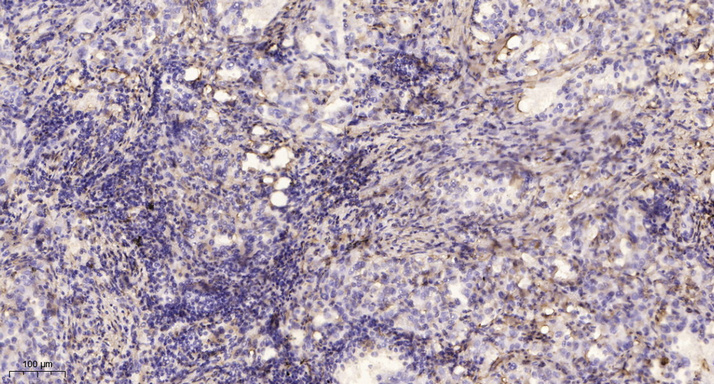Myosin VA Polyclonal Antibody
- Catalog No.:YT2950
- Applications:WB;IHC
- Reactivity:Human;Mouse;Rat
- Target:
- Myosin VA
- Fields:
- >>Pathogenic Escherichia coli infection
- Gene Name:
- MYO5A
- Protein Name:
- Unconventional myosin-Va
- Human Gene Id:
- 4644
- Human Swiss Prot No:
- Q9Y4I1
- Mouse Gene Id:
- 17918
- Mouse Swiss Prot No:
- Q99104
- Rat Gene Id:
- 25017
- Rat Swiss Prot No:
- Q9QYF3
- Immunogen:
- The antiserum was produced against synthesized peptide derived from human MYO5A. AA range:1784-1833
- Specificity:
- Myosin VA Polyclonal Antibody detects endogenous levels of Myosin VA protein.
- Formulation:
- Liquid in PBS containing 50% glycerol, 0.5% BSA and 0.02% sodium azide.
- Source:
- Polyclonal, Rabbit,IgG
- Dilution:
- WB 1:500-2000;IHC 1:50-300
- Purification:
- The antibody was affinity-purified from rabbit antiserum by affinity-chromatography using epitope-specific immunogen.
- Concentration:
- 1 mg/ml
- Storage Stability:
- -15°C to -25°C/1 year(Do not lower than -25°C)
- Other Name:
- MYO5A;MYH12;Unconventional myosin-Va;Dilute myosin heavy chain; non-muscle;Myosin heavy chain 12;Myosin-12;Myoxin
- Observed Band(KD):
- 220kD
- Background:
- This gene is one of three myosin V heavy-chain genes, belonging to the myosin gene superfamily. Myosin V is a class of actin-based motor proteins involved in cytoplasmic vesicle transport and anchorage, spindle-pole alignment and mRNA translocation. The protein encoded by this gene is abundant in melanocytes and nerve cells. Mutations in this gene cause Griscelli syndrome type-1 (GS1), Griscelli syndrome type-3 (GS3) and neuroectodermal melanolysosomal disease, or Elejalde disease. Multiple alternatively spliced transcript variants encoding different isoforms have been reported, but the full-length nature of some variants has not been determined. [provided by RefSeq, Dec 2008],
- Function:
- disease:Defects in MYO5A are a cause of Elejalde syndrome [MIM:256710]; also known as neuroectodermal melanolysosomal disease. Elejalde syndrome is an autosomal recessive condition characterized by skin hypopigmentation, the presence of large clumps of pigment in hair shafts, silvery-gray hair, accumulation of melanosomes in melanocytes and primary neurological abnormalities. Elejalde syndrome may be the same entity as Griscelli syndrome type I.,disease:Defects in MYO5A are a cause of Griscelli syndrome type-1 (GS1) [MIM:214450]; also known as Griscelli syndrome with primary neurologic impairment. Griscelli syndrome is a rare autosomal recessive disorder that results in pigmentary dilution of the skin and hair, the presence of large clumps of pigment in hair shafts, silvery-gray hair and accumulation of melanosomes in melanocytes. GS1 patients show developmental delay, hypotonia and ment
- Subcellular Location:
- ruffle,photoreceptor outer segment,cytoplasm,lysosome,early endosome,late endosome,peroxisome,endoplasmic reticulum,Golgi apparatus,cytosol,intermediate filament,actin filament,membrane,myosin complex,gr
- Expression:
- Detected in melanocytes.
- June 19-2018
- WESTERN IMMUNOBLOTTING PROTOCOL
- June 19-2018
- IMMUNOHISTOCHEMISTRY-PARAFFIN PROTOCOL
- June 19-2018
- IMMUNOFLUORESCENCE PROTOCOL
- September 08-2020
- FLOW-CYTOMEYRT-PROTOCOL
- May 20-2022
- Cell-Based ELISA│解您多样本WB检测之困扰
- July 13-2018
- CELL-BASED-ELISA-PROTOCOL-FOR-ACETYL-PROTEIN
- July 13-2018
- CELL-BASED-ELISA-PROTOCOL-FOR-PHOSPHO-PROTEIN
- July 13-2018
- Antibody-FAQs
- Products Images

- Immunohistochemical analysis of paraffin-embedded human lung cancer. 1, Antibody was diluted at 1:200(4° overnight). 2, Tris-EDTA,pH9.0 was used for antigen retrieval. 3,Secondary antibody was diluted at 1:200(room temperature, 45min).



